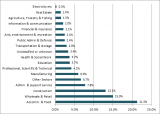Continuing our analysis of the economic and social impacts of the Covid 19 pandemic on the Western Region it is useful to look at the number in Western Region counties in receipt of the Pandemic Unemployment Payment (PUP) today, 19th May.
The Department of Employment Affairs and Social Protection has provided a county breakdown for the (PUP) payments , valued at €201.8m, just issued to 585,000 people (of which 252,800 are female and 331,800 are male). The Covid-19 Pandemic Unemployment Payment (PUP) is an emergency payment for employees and the self-employed who have lost their income and are fully unemployed due to the pandemic. It is paid at a rate of €350 per week into a recipient’s bank account.
While the PUP is the most significant payment, there are also over 54,000 employers who have registered with the Revenue Commissioners for the Temporary Covid-19 Wage Subsidy Scheme (TWSS) with at least one subsidy being paid in respect of over 464,000 people under that scheme (there is no county breakdown available for this). These payments are in addition to the 214,700 people who were reported on the Live Register as of the end of April[1][2].
The Pandemic Unemployment Payment (PUP) in the Western Region
Of the 585,000 in receipt of the payment, 102,800 are in the Western Region. This accounts for 17.6% of the national total while the Western Region accounted for 16.8% of the Labour Force in 2016 (the most recent data at this level). The number in receipt of the PUP has fallen slightly (2.2%) from 598,000 on 5th May (104,900 in the Western Region) as some recipients have begun to return to work and some employers have entered the TWSS.
Figure 1 shows the number of people in receipt of the PUP in the Western Region counties and in Kerry and Limerick, which, along with the Western Region counties, make up the Atlantic Economic Corridor (AEC). In the Region, Galway (31,800) and Donegal (22,200) have the most people in receipt of the payment, with more than 20,000 people also receiving the payment in Kerry and Limerick. Leitrim (4,000), Roscommon, (6,900) and Sligo (7,500), the smaller counties, have the lowest number of recipients (and the smallest numbers nationally, along with Longford (4,500) and Carlow (7,500)).

Figure 1: Number of people in receipt of Pandemic Unemployment Payment on 19th May in Western Region and AEC counties
Clearly the most populous counties have the highest numbers of recipients so it is more useful to consider the percentage of the Labour Force in receipt of the payment. The most recent available county data on the size of the Labour Force is from Census 2016, and although the national labour force has increased since then, the Census data is used here[3] to allow for a comparison of rates by county (Fig 2).
Nationally (using the 2016 denominator), 25% of the labour force were in receipt of the PUP, but 27% of those in the Western Region labour force were receiving it. There is very significant variation among Western Region counties, with 31% of the labour force in Donegal in receipt of PUP but only 23% of those in Roscommon (the only Western Region county to be below the state average). Looking at the other AEC counties, Limerick (24%) is also lower than the State but Kerry, like Donegal, is very high (31%).

Figure 2: Percentage of County Labour Force (2016) in receipt of Pandemic Unemployment Payment
There is no county breakdown available for the Temporary Covid-19 Wage Subsidy Scheme (TWSS) which some unemployed workers receive instead of the PUP and so it is not clear what influence this would have on these figures. The importance of different sectors for employment discussed in a previous blog, and in turn the different impact of Covid 19 public health measures on various sectors, all affect the level of PUP payments in each county.
Reliance on key sectors
The job losses have been largest in sectors where economic activity is difficult or impossible because of public health measures and social distancing guidelines (the recent Working Paper from the DEASP discusses sectors in more detail) Three sectors, Accommodation and Food Services (21.3%), Wholesale and Retail (15.0%) and Construction (13.1%) together account for almost half (49.4%) of all those in receipt of the PUP (Figure 3).

Figure 3: Pandemic Unemployment Payments – Sector Breakdown, Payment 19th May.
This is in line with the most recent CSO Business Impact of COVID-19 Survey 20 April to 3 May 2020 (published 18th May) which shows that 69.1% of enterprises in Accommodation and Food services ceased trading, either temporarily or permanently while two thirds (66.7%) of responding enterprises in the Construction sector had ceased trading either temporarily or permanently as of 3 May 2020.
The Western Region is particularly reliant on these sectors (as shown in Census 2016) with 12.7% of total employment in 2016 in Wholesale and Retail and higher dependency on Accommodation and Food Services in the Western Region (6.9%) and Construction (5.4%) than the rest of the state (5.6% in Accommodation and Food; 5.0% in Construction).
While the county data for the sectoral breakdown of the PUP is not available, Figure 4[4] is taken from the recent DEASP Working Paper (PDF 1.7MB) which shows the breakdown of the payments in each county for the week ending 17th April[5]. The importance of the Accommodation and Food Services sector in the Region, and along the Atlantic Economic Corridor, is clear.

Source: DEASP Working Paper , May 2020 Figure 6 . Apologies for the poor quality. The key sector of Accom & Food is at the bottom (dark blue), Construction is large blue section in the middle and Wholesale & Retail is at the top (orange).
The Accommodation and Food sector is most important along the Western Seaboard , this takes in the five counties (Kerry, Sligo, Clare, Mayo and Galway) with the greatest proportion of those claiming the PUP in this sector. In Kerry almost 30% of those claiming the PUP were employed in Accommodation and Food services, along with more than a quarter of those claiming PUP in Sligo, Clare and Galway, and more than 20% in Donegal, Leitrim and Limerick. Of the Western Region counties, only Roscommon had fewer than 20% of PUP claimants in that sector. This is in line with its relatively low percentage in receipt of the PUP (Fig 2 above).
Conclusion
While there is variation in the impact of the Covid 19 among Western Region counties, the consequences for the Region as a whole are clearly significant. As discussed previously the pattern of employment in the Western Region compared to the rest of the state has both positive and negative aspects in this current crisis. Higher dependence on Accommodation and Food services means more vulnerability but, in the short term, the greater reliance on public service employment can provide more stability and resilience.
As the ESRI noted, there was an almost total decline in certain types of economic activity from mid-March onwards. With some working in Wholesale and Retail able to return to work this week (18th May), and more expected form the 8th June, we can expect some decrease in the numbers receiving the PUP in the next payment round but Accommodation and Food services such as cafes, restaurants and pubs will main closed longer. As many outlets, particularly in the retail, food and hospitality sectors, simply stopped trading and in these key sectors remote working was generally not an option, it is not clear how many of these will be in a position to resume trading when the shutdown period ends.
This series of posts brings together new data and previous WDC analyses and examines them from the perspective of the possible impacts of the Covid 19 pandemic on the regional economy. The posts aim to develop our understanding of what may be happening at a regional level and what will need to be done in the later phases of the public health emergency and beyond, but they are early interpretations and should be viewed as a work in progress rather than a definitive commentary.





